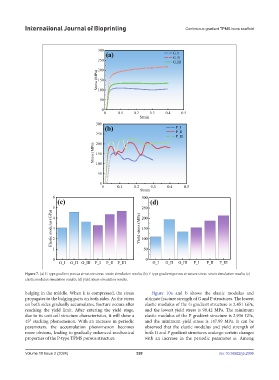Page 328 - IJB-10-2
P. 328
International Journal of Bioprinting Continuous gradient TPMS bone scaffold
Figure 7. (a) G-type gradient porous structure stress–strain simulation results; (b) P-type gradient porous structure stress–strain simulation results; (c)
elastic modulus simulation results; (d) yield stress simulation results.
bulging in the middle. When it is compressed, the stress Figure 10a and b shows the elastic modulus and
propagates to the bulging parts on both sides. As the stress ultimate fracture strength of G and P structures. The lowest
on both sides gradually accumulates, fracture occurs after elastic modulus of the G gradient structure is 2.451 GPa,
reaching the yield limit. After entering the yield stage, and the lowest yield stress is 98.42 MPa. The minimum
due to its unit cell structure characteristics, it will show a elastic modulus of the P gradient structure is 2.936 GPa,
45° stacking phenomenon. With an increase in periodic and the minimum yield stress is 147.99 MPa. It can be
parameters, the accumulation phenomenon becomes observed that the elastic modulus and yield strength of
more obvious, leading to gradually enhanced mechanical both G and P gradient structures undergo certain changes
properties of the P-type TPMS porous structure. with an increase in the periodic parameter ω. Among
Volume 10 Issue 2 (2024) 320 doi: 10.36922/ijb.2306

